Even though the Heckler & Koch Maschinenpistole 5 (H&K MP5) 9mm submachine gun came out in 1964, like the AR-15 of similar vintage, it has become a legend and influenced global gun culture far beyond the reach of the original models. There are many variants, most of which are not properly called MP5s but all of them share some of the mystique.
With the introduction of the HK SP5 pistol, (MSRP $2799), H&K has created new interest in the MP5 family. This pistol will give H&K fans a new model with all the markings and appeal of a real H&K gun. The availability of arm braces and the popularity of short barrel rifle conversions make these new pistols more interesting than their 1980’s ancestors.
The MP5 was the go-to submachine gun of the cold war. It was a Hollywood chick magnet and the movies made it the sex symbol of a generation. IMDb lists fifty-two “Hk 5 Machine Gun Movies” where the gun is credited as one of the stars. Where the MP5 came from and where it went is a twisted tale of terrorism and ballistics.
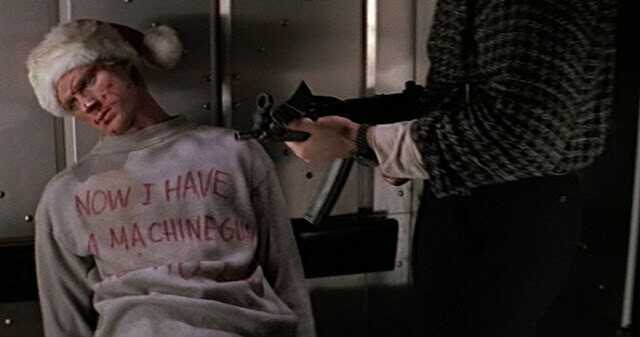
Photo courtesy of Twentieth Century Fox
I have a deep and abiding love for the MP5 and its variants, but it is not blind. These guns have a unique appeal but they have their idiosyncrasies. They are historic icons, fun to shoot and very effective when used appropriately.
The MP5 story begins as Nazi Germany ends. Too late to win the war, Germany’s engineers developed advanced Wunderwaffe (Miracle Weapons). One of these, the Sturmgewehr 44 (StG44), was named by Hitler himself. Its propaganda name was so appealing, it is used by anti-gunners today. It literally translates to “assault rifle.”
The StG44 is an uncle, but the father of the MP5 is a Mauser’s prototype which never reached production. The StG45 design was a product improved Sturmgewher which was easier to mass-produce. This Mauser prototype used two small roller cams to provide a slight delay to allow the pressure in the barrel to fall before the bolt starts to move backward. This elegant design eliminates the need for a gas system. The barrel is floated and there is no gas port to affect accuracy.
After World War 2, Mauser’s factories were taken over by the French. Two of the Mauser engineers, Dr. Ludwig Vorgrimler and Theodor Loffler, perfected the roller delayed blowback design in a rifle. The French, then involved in Vietnam, canceled the project.
Dr. Vorgrimler later joined other German engineers at CETME in Spain producing the first commercial rifle to use roller-delayed blowback. In 1956, the German Army (Bundeswehr) adopted the CETME Model B rifle and asked H&K to make it. They called it the Gewehr 3 (Rifle Model 3) or G3.
Vorgrimler eventually moved to Heckler & Koch and developed a family of small arms based on their 7.62 NATO G3 with guns chambered in the AK-47’s 7.62×39mm round, the M-16’s 5.56 NATO round, and the 9×19mm pistol cartridge.
Like the Sturmgewehr, the MP5 was designed for wartime production using a stamped sheet metal receiver and pressed in cold hammer-forged barrel. It is rugged and reliable because of careful tolerances, a wide extractor, and a fluted chamber.
In the 1960s almost all submachineguns fired from the open bolt. This means that the bolt is locked open until the trigger was pulled. The direct blowback bolt must be heavy causing large weight shifts when it moves. When the trigger is pulled, the bolt slams forward making precise shots difficult. The MAC-10, Uzi, Sten gun, MP38 and the M-3 Grease Gun all fired from the open bolt. The MP5 was a revolutionary change, reliable and fired precisely from the closed bolt.
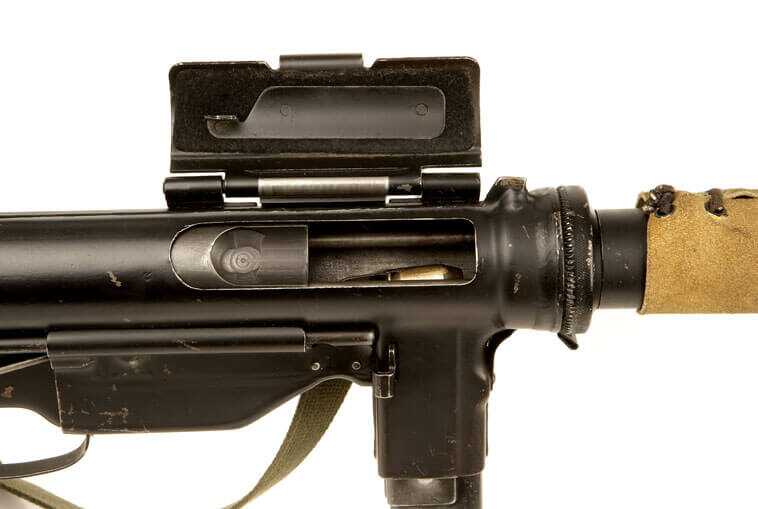
The U.S. Submachine Gun, Caliber .45, M3 (Greasegun) was America’s stamped sheet metal machinegun driven by similar requirements to the StG45 for economical mass production. Delta Force started with the M-3 Grease gun and quickly figured out they were unsuited for hostage rescue. They switched to the MP5. Even though the MP5 saw limited use in Vietnam with MACV-SOG, they didn’t catch on with the U.S. Army until they were adopted by Delta.
In 1980, the British Special Air Service stormed the Iranian Embassy in London on live television during Operation Nimrod. Using MP5s, they killed five terrorists, rescued nineteen hostages (sadly, one hostage died and two were injured in the crossfire). The MP5 was instantly famous.

The MP5 became popular with SWAT units in the United States and with police and militaries across the planet. I saw them in foreign weapons training in Special Forces, but my first real experience with the MP-5 was when I was issued one as a U.S. Customs agent. The things I am about to tell you may seem strange. I did not learn them on the internet. I learned them from H&K’s at their MP-5 Instructor School and Armorer School.
Ergonomics
Why is the original MP5 so awkward to use left-handed? In the German Army, it was forbidden to shoot left-handed. Why is the selector/safety difficult to manipulate with the right hand? The “master grip” of the right hand should never shift. H&K teaches that you should use the left hand to reach over the gun and manipulate the selector.
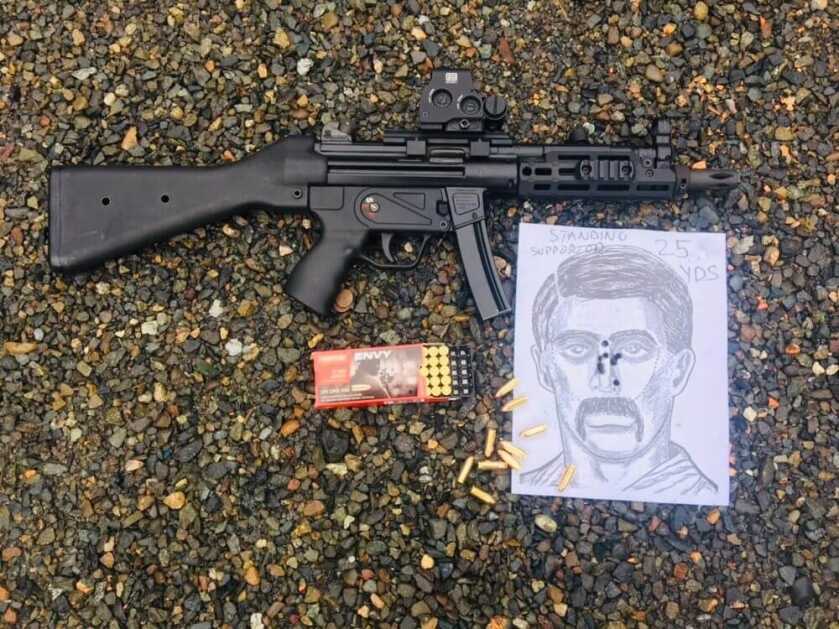
Later versions offered a collapsible stock. It is long and had only two positions, collapsed and open. When it is extended into its single extended length, it wobbles (later models fixed the wobble).

The collapsible stock is higher than the fixed stock. A cheek weld is difficult and to put your eye behind the sights requires you to fold your face around the stock. When you shoot it, you get the sensation of being hit in the face with a piece of rebar. Use of optics raises the face helping this.
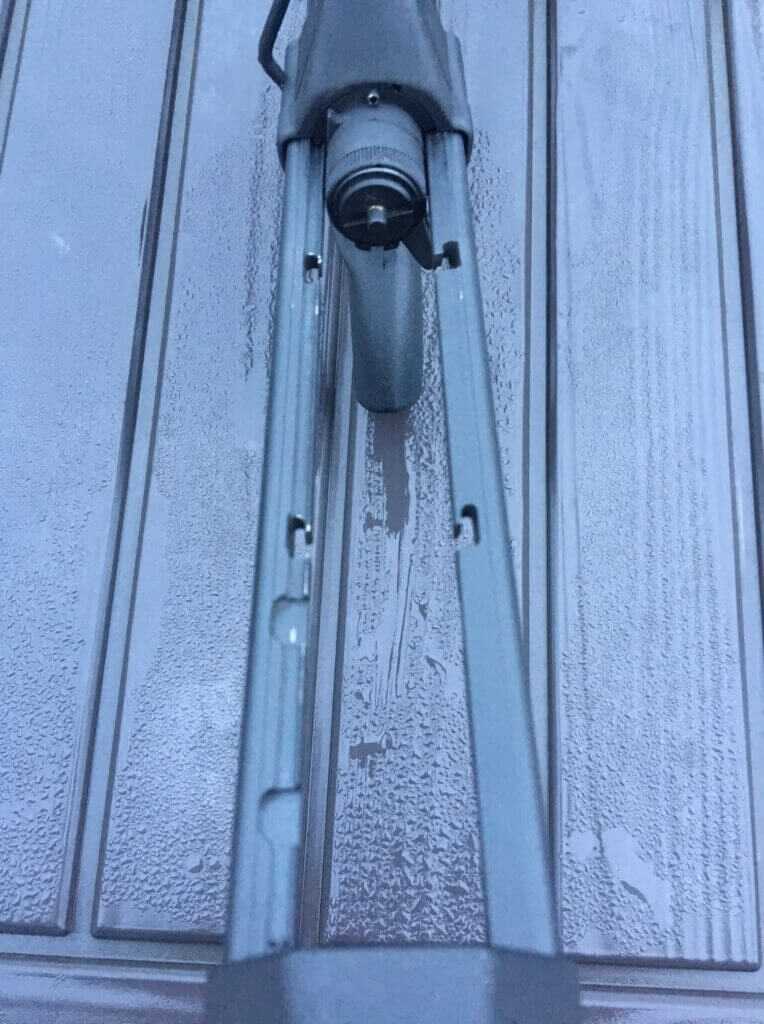
I took our SWAT team MP5s and had the agency armorer cut an extra notch into the collapsible stock, so the length of pull would fit when we were wearing body armor. I measured the pull for each man to an optimal custom length like a fine English shotgun. This had the additional benefit of removing that irritating wobble.
When they noticed the rough cuts in my short stock in the MP-5 Armorers class, they looked at me as if I had just kicked a puppy. They were nearly apoplectic and told me such modifications were unnecessary and forbidden. (It sounds better in the original German “Verbotten”).
Magazine Changes
This is a story in itself. Apparently, in Europe, human life is cheap and magazines are scarce and valuable. Europeans don’t drop magazines. One of my mentors was involved in bringing the Sig handgun to the Arizona Department of Public Safety. The magazine base plates were popping off. This seemed so bizarre to the Sig that they flew an engineer to Arizona to investigate. This malfunction had never before been observed in Europe. The engineer watched the Americans shoot and with deft Teutonic insight, he quickly determined the problem. He angrily called back home and told them “Mien Gott, the Americans drop magazines on the ground!”
Having paid retail for H&K magazines, I can understand some of that. Sooo, how do you change an MP5 magazine? The first requirement is to recognize the magazine is empty. There is no last round bolt hold open on the MP5. When I asked one of my H&K instructors about this, he sneered and said, “You don’t want your enemy to know when your gun is empty.” I replied, “I think at least one of us should know.”
The first step in the MP5 reload; guess your gun is empty. You never know for sure until the hammer drops on an empty chamber. Now you must reach forward and pull the cocking handle back and lock it to the rear. On the typical reload, this launches a live round on to the ground. I guess ammo is plentiful in Europe. Then you grab the magazine and hit the flapper with your thumb. This design forces you to grab the magazine.
At this point, you may as well retain the magazine because this is not a quick process and hey, those are some pricey mags. Once you get a new mag in position, you lock it in, slap the cocking handle, allowing the bolt to go forward, chambering a round.
Magazines
The MP5 uses a double-column double-feed box magazine. This is an incredible design and my favorite submachine gun magazine of all time. Quarter Circle 10 makes a 9mm AR which uses this outstanding magazine.
The 30 round mags hold 31 rounds. This is a mixed blessing. They will not load under a closed bolt with more than 30 rounds. If you attempt to cheat the H&K design features and tactical reload on a closed bolt, you are flirting with disaster. You may have an empty chamber. You may not be able to insert the mag if you have 31 rounds.
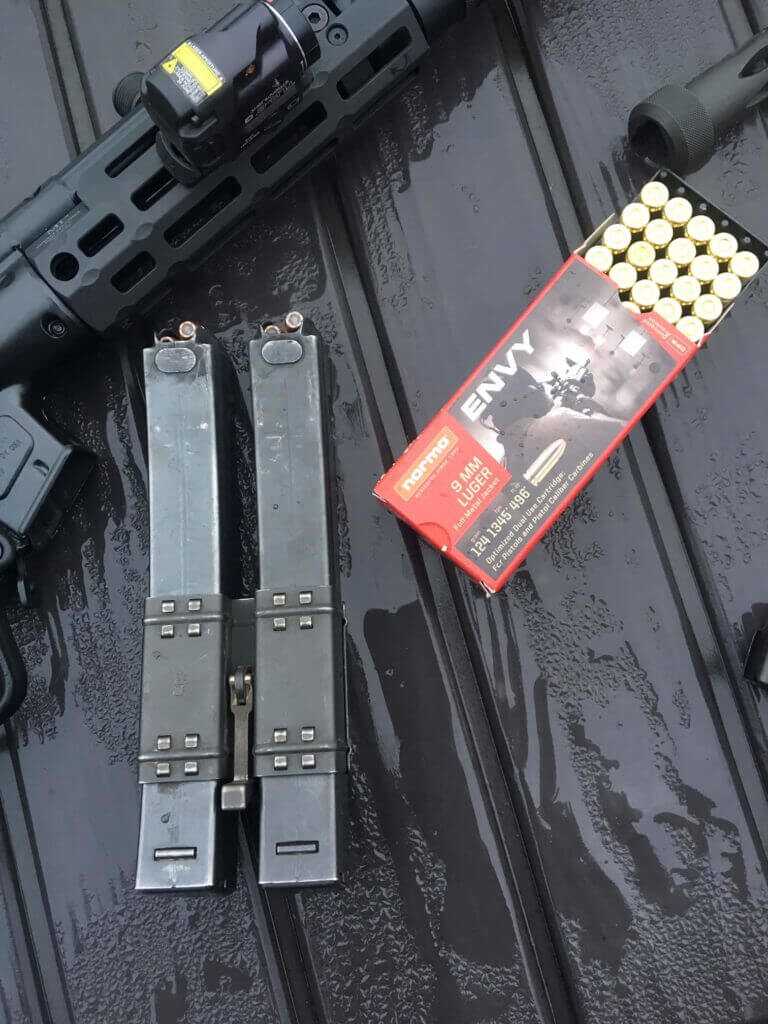
H&K makes a mag clamp that holds two magazines together. They are expensive. I found that if I put both mags pointed up, it shifted my arm out disrupting my tight CQB shooting position. When the mags are both up, you shift it quickly to the right and reload. Since you have to retain the mag anyway, it is a good idea. I put one up and one down so that the extra magazine remained on the left side of the gun.
When I showed up for the MP5 instructor class, my H&K instructor told me gently (read this with a slight German accent) “Your magazine is upside down.” I explained my situation and my solution. I had been carrying the MP5 as a duty gun for 3 years at that point. He smiled as though speaking to a moron. He said (again read this with the accent) “How do you reload?” I dropped the mag, rotated the gun 90% to the right, the mag 90% to the left and reloaded. “Like this,” I said. He looked at me as though I had just slapped a kitten. After several seconds, he said “Do not do that here” and walked away. I was not honor graduate in that class.
I have thirty-year-old magazines that still function perfectly. The only issue I ever had with OEM MP5 magazines is with corrosion. They will get surface rust and you have to constantly monitor them. They still function fine but begin to look like trash. I prefer the 20 and 30 round mags from KCI USA. They have an electrocoating which is slick and resists rust. The 20 rounder is useful when size and weight are at a premium.
Disassembly
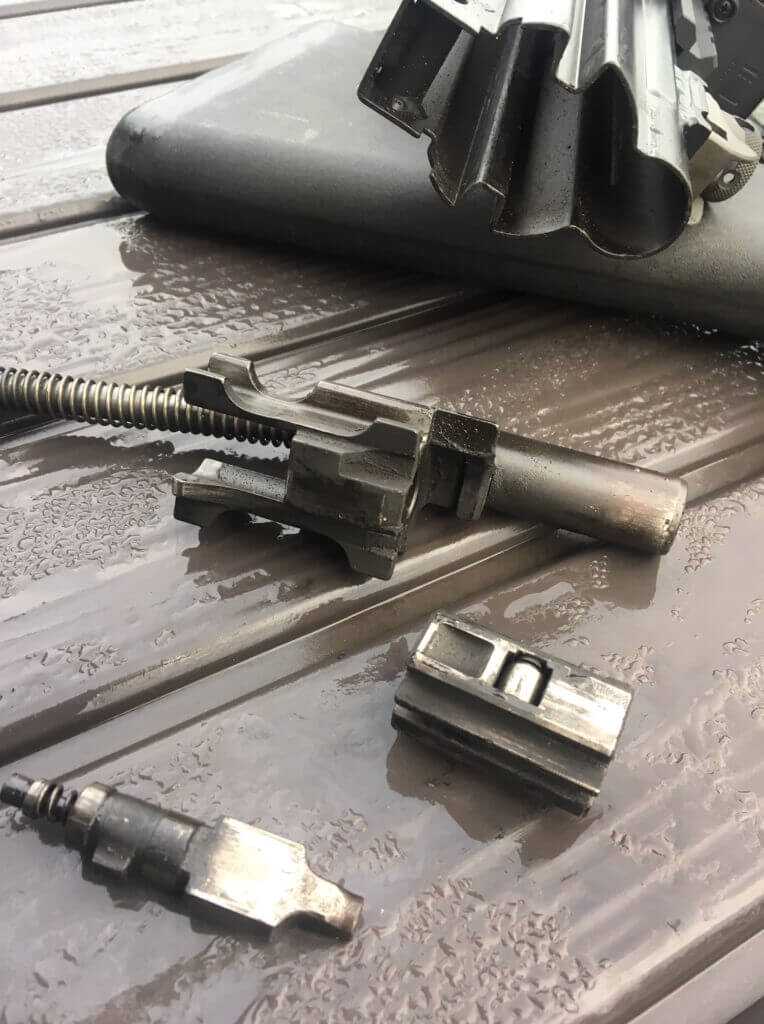
Disassembly is not too difficult. It is harder than an AK and easier than an AR. It takes a bit of head-scratching to figure out the delayed roller blowback system. One of the things I found endearing about the fixed stock was the two holes in it. The takedown pins are stored in these holes when the gun is disassembled. How orderly!
Trigger
The trigger is OK. The original SEF trigger group is simple and rugged. So-called because the markings are literally SEF; in German, this stands for Sicher (Safe), Eine (One) and Feuer (Fire).
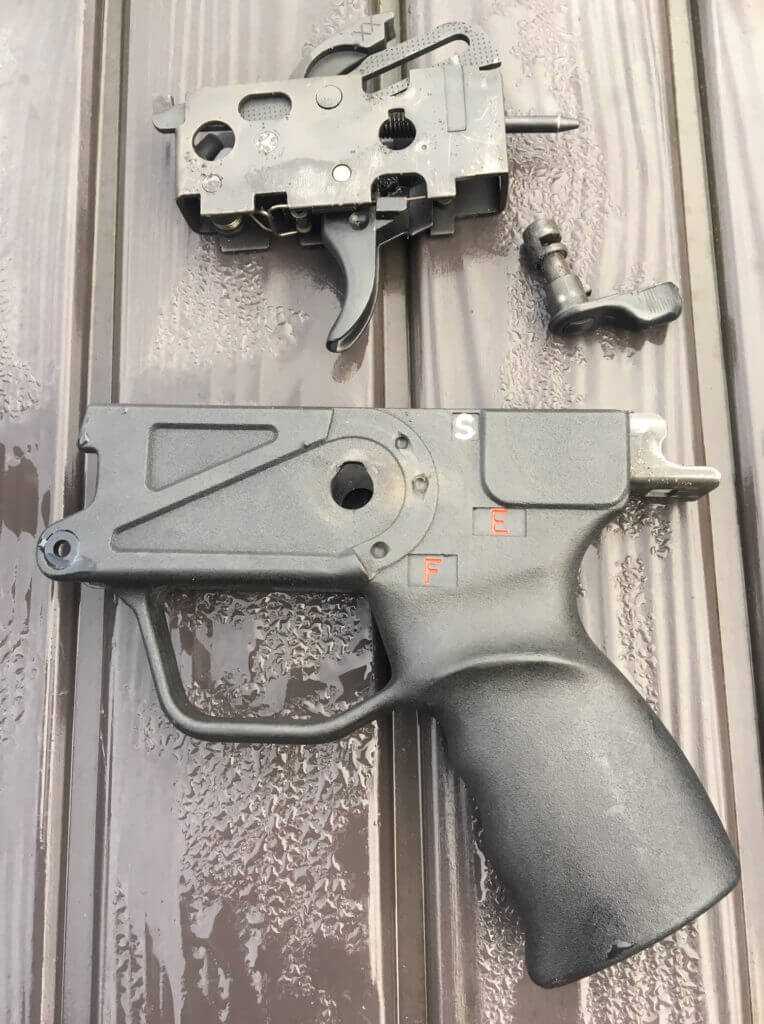
Once the American DEA started buying H&K guns, things changed, they wanted to buy a 3-round burst rather than teach trigger control. Those genius bastards at Oberndorf crammed three times as many parts into the same space and invented a working 3 round burst which, unlike the M-16A2, resets, so every burst is 3 rounds. It is a masterpiece of engineering just like those advanced designs which lost WWII.
The bad news. They had to send the trigger groups back to Oberndorf for repair because they couldn’t explain it in English. They later corrected this. This is also when the pictographs (pictures of rounds next to the selector) appeared. Not only could non-Germans figure it out, but even illiterates could shoot it!

The Zenith custom shop does an amazing MP5 trigger job. It takes the slop out and gives a nice clean break and a nice reset.
Reliability
The MP5 is pretty reliable. It will shoot dirty but it does not tolerate debris in the locking cam detents. I have read that NASA (yes that NASA) security has one MP5 they have logged over 1 million rounds through. It is so over-designed I have no difficulty believing this.
The DEA contract guns we had in the Customs Service came with a flash hider, night sights, an ambidextrous selector (which can equally not be manipulated by either hand) and an ambidextrous sling. This sling hangs the gun from the pin that holds the stock on the gun. If the sling swivel bolt loosens up, the gun will disassemble itself. That is some high adventure stuff right there.
The most common wear or breakage part on the MP-5 is the copper-colored extractor spring. The extractor spring is made from a steel paper clip that is plated in copper and it just breaks after a while. H&K says to replace it each year.
I have also seen the roller retainers break, but this part only holds the rollers in place for disassembly. The gun runs fine without it.
With that said, you still should get thousands of rounds of use from both items before needing to replace either item. All in all, the MP-5 is a super robust firearm with very little maintenance required.
Zeroing
This goes back to another quaint European idea. Shooters shouldn’t adjust the sights. Expert craftsmen in Obendorf adjusted those sights; you will just screw it up. The sight tool is designed to PREVENT the adjustment of sights unless you pay the toll. It is like the key to a lock.
The rear sight has a rotating drum with different size apertures. Unlike the G-3 rifles, these holes don’t change the point of impact; they just let different amounts of light through.
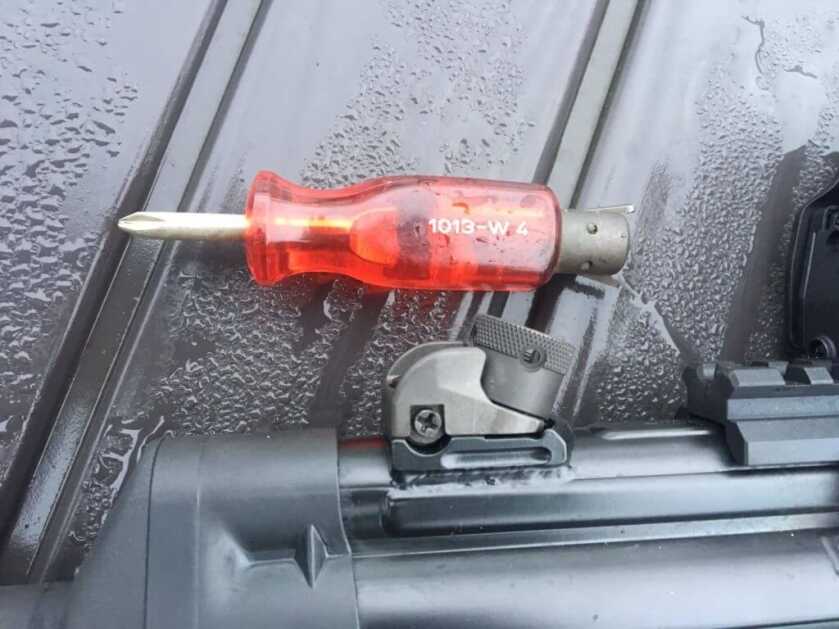
Barrel
The fixed, free-floating, cold hammer-forged barrel has 6 right-hand grooves with a 1:10 in) rifling twist rate and is pressed and pinned into the trunion.
The Germans developed the hammer-forge process to quickly mass produce millions of machine guns barrels. Hydraulic powered steel hammers shape the barrel around a form called a mandrel which shapes the chamber, the lands, and the grooves.
The metal is formed cold. This work hardens the metal, which allows it to better tolerate the stress and heat of a full-auto fire. It also provides a smooth bore promoting accuracy. The process introduces stress in the metal, which can affect negatively accuracy if it is not relieved.
A unique feature that marks all MP-5 brass is the fluted chamber. Fluting enhances extraction reliability by bleeding gases backward into the shallow grooves inside the chamber to prevent the cartridge case from expanding and sticking to the chamber walls.
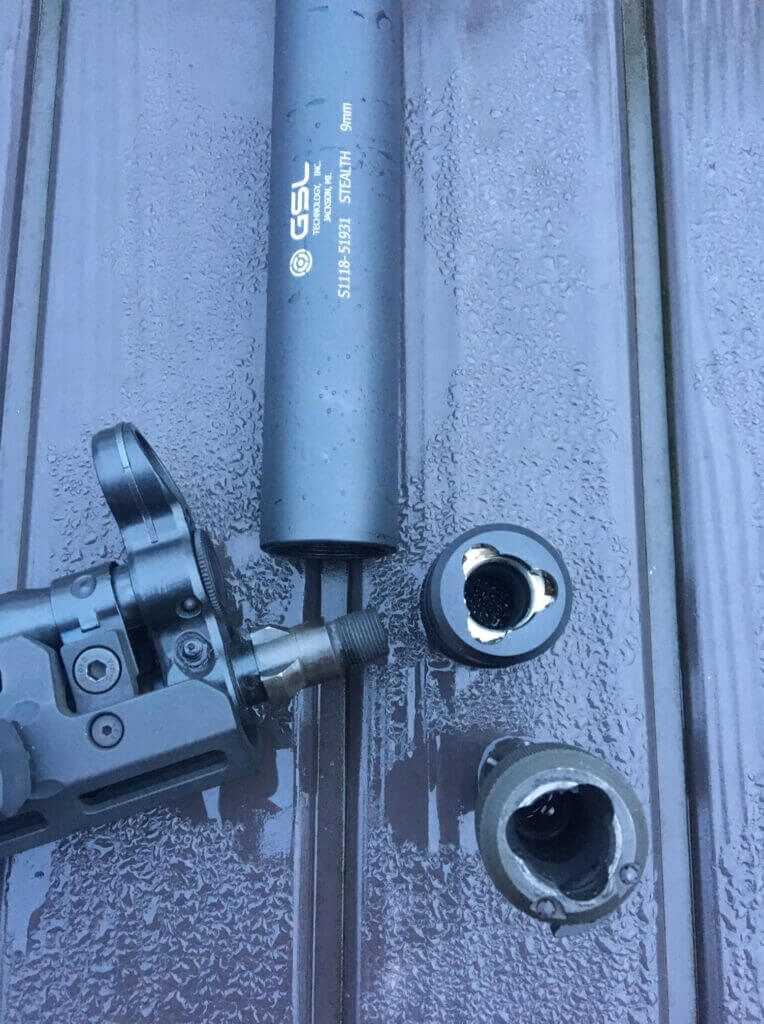
One of the most innovative features of the MP-5 is often taken for granted, the three-lug barrel. It was originally designed by H&K to mount blank firing adapters, flash suppressors and a grenade launching adapter.
The true potential of the 3 lug was later developed and patented by Tim Bixler in 1988. Bixler’s spring-loaded suppressor mounts made the installation of 3 lug accessories simple and solid. Later, the H&K “NAVY” barrels added 1/2-28tpi threads in front of the 3 lugs making the barrel compatible with both direct thread suppressors and muzzle devices. H&K 3 lug adapters are now the standard for quick detach capability for pistols and pistol caliber carbines of all manufacturers.
Accuracy
The adjustable iron sights consist of a rotating rear diopter drum and a front post installed in a hooded ring. The rear sight is mechanically adjustable for both windage and elevation with the use of a special tool.
The rear sight drum has four diopter system apertures. Changing between apertures does not change the point of impact. The shooter should select the aperture that provides the best sight picture (equal circle of light between the rear sight aperture and the outside of the front sight hood ring) for the target and light conditions.
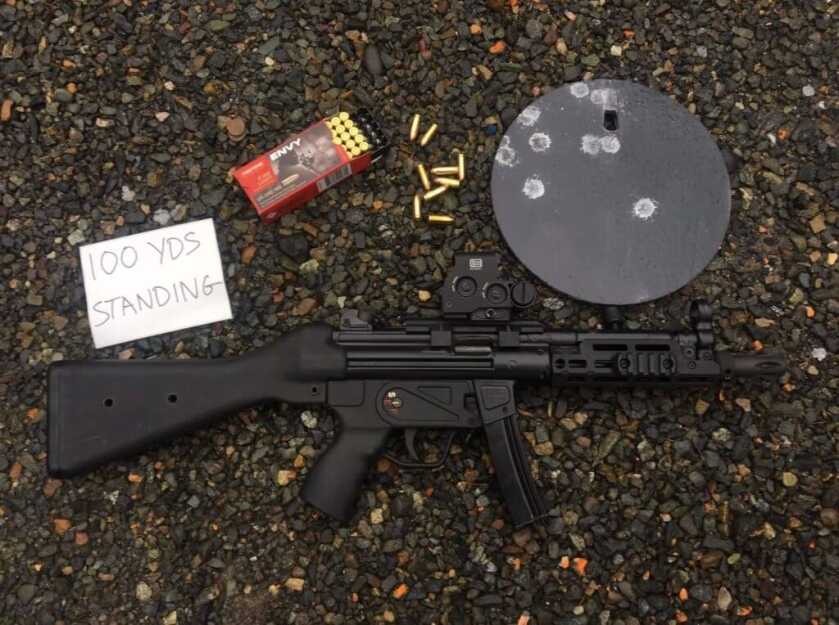
With iron sights, it is difficult to hit a head at 100 meters. Out to 25 meters, it is surgical. There are optic mounts which grip the lugs on the MP-5 receiver. A dot sight on one of these mounts goes a long way towards making the collapsible stock eye relief work.
The receiver has a proprietary claw-rail mounting system to attach an H&K quick-detach claw mount.

Times Change
On February 28, 1997, two armored bank robbers absorbed approximately 650 rounds fired by the Los Angeles Police Department (LAPD) in the North Hollywood district. One robber shot himself and the other succumbed to wounds. The bank robbers had fashioned full body armor which made them virtually impervious to the 9mm Berettas of the LAPD.
North Hollywood led law enforcement’s re-evaluation of the effectiveness of handgun rounds against criminals in body armor and began the wide-scale use of the patrol rifle. Police and SWAT replaced most of their MP5s with rifle caliber carbines. The M-4 became America’s sweetheart and the MP5 became the retro gun favored by people who don’t understand physics.
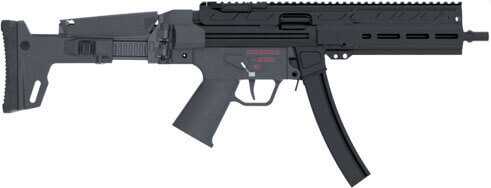
While it is no longer the gun of choice on the battlefield, the MP5 is a piece of history and a very reliable 9mm platform. Americans can still get these in all flavors from HK94 to MP5SD as well as G-3 clones.
Featured Photo: Modified HK94 with GSL Stealth suppressor, KCI USA magazines, Streamlight TLR-8 G, ETS Magazine loader, H&K sight adjustment tool, and NORMA Envy 9mm PCC ammunition.


Does the SAS still use the the mp5?
Whilst my HK 93 is deadly accurate, I find the clacking of the roller system to be slightly annoying compared to a traditional gas system as in the AR’s.
I also dislike the lack of a last round bolt lock, it seems like such an easy thing not to do.
Thanks for the great article Mark. While assigned to USCS Internal Affairs, Boston, we had three MP-5’s. Full auto, not three round burst. The agents upstairs, Office of Investigations, had MP-5’s limited to three round bursts. Try to figure that one out! OI was chasing drug smugglers and OC types and my office was chasing Customs employees! Who needed the most firepower and who got it! The MP-5 was fun to shoot! NOTE: I was never required to use it on an employee!
John Shirley
Glad you never had to shoot an employee. I did a few SRT warrants for Internal Affairs. It was gratifying cleaning up the trash.
You guys did great work getting bad inspectors and agents out of the agency.
***
Thank you for the remarkably good article! I always wondered how the roller delayed system works. Far simpler than gas pistons, tilting barrels, rotating bolts, etc.
***
Shooting 1 MILLION! rounds out of an MP5 makes me wonder why the folded metal guide parts in the stamped sides don’t wear out as the bolt assembly “scrapes” them. Good case hardening or heat treating on the steel? Replacing the sheet metal every so often or every so many thousands of rounds fired?
***
I can imagine the German instructors thinking DUMKOF! when they saw what you had to do to make the H&K design more useful to an actual troop counting on it to work properly and accurately. American G.I.’s are famous for improvising stuff! And coming up with the right answers to problems that the “brass” claim don’t exist–in their ivory tower world.
***
John Bibb
***
HK also used the roller locking design for the P9S family of pistols called “mini rifles” by Massad Ayoob because of their amazing accuracy. HK made them primarily in 9mm and .45 acp with a small number of other “oddball” Euro calibers. The P9S was I believe the second polymer pistol on the market following the HK VP70.
After watching the forgotten weapons video on the vp70m id trade 2 mp5s for one vp70m with stock and 10 mags. Then id be looking for .14 a round fmj By the pallet! That is a much cooler gun to me!
Good article and kudos for mentioning the talents of Tim Bixler. Was a friend and neighbor of mine.
That was some interesting “inside baseball” stuff. As an HK fan, thanks to the author.
Tim Bixler was a genius and deserves a lot of credit for his innovations.